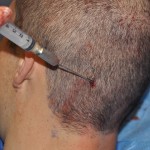Background: One of the most common aesthetic skull deformities is a flat back of the head. Caused by either genetics or external deformational forces in utero or after birth, the lack of adequate projection in the occiput can be aesthetically disturbing to some people. While often camouflaged by hair, it can still be a concern and is even more so by men who shave their heads or have very short hair.
Like forehead augmentation on the opposite side of the skull, occipital augmentation can be done by a variety of materials and techniques. By far the best occipital contouring technique is the use of a custom implant made from the patient’s 3D CT scan. This has become a very popular method used today due to its prefabrication of shape and thickness as well as the ability to limit incision size. But not everyone can use a custom implant approach for a variety of reasons. In these cases the traditional technique of implanting PMMA bone cement is used with intraoperative shaping and contouring is done. This requires no presurgical lead or fabrication time.
Despite the success of occipital augmentation surgery, some patients would like the augmentation to extend lower. Without realizing it their desired zone of enhancement is off of the bone and onto the neck muscles. Most people do not realize that the bottom end of the occipital bone (nuchal line) is at the level of the upper 1/3 of the ear. Thus bone cements can not be extended that low. Any augmentation below this back of the head level (which is not that commonly requested) must be done by soft tissue augmentation methods.
Case Study: This 26 year-old male had been bothered by his flat back of the head since he was a teenager. In determining his back of the head augmentation goals, which he provided by drawings, it could be seen that he wanted an augmentation effect that went below the nuchal line.


Case Highlights:
1) Occipital (back of the head) augmentation can be done by a variety of materials of which PMMA bone cement is the most economical.
2) The extent of occipital augmentation ends inferiorly near the nuchal line at the base of the skull which lies roughly at the level of the top of the ear.
3) Augmentation below the nuchal line must be done with fat injections over the neck muscles.
Dr. Barry Eppley
Indianapolis, Indiana


